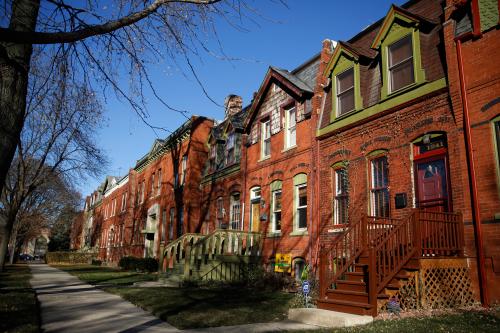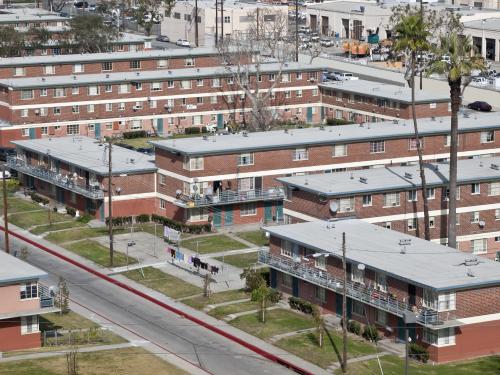This post is part of a series highlighting innovative strategies and tools designed to help increase and diversify the supply of quality rental housing in opportunity and priority reinvestment areas. Over the course of this year, Brookings Metro is convening a Community of Practice on Regional Housing Solutions, bringing together a diverse array of partners from the Baltimore, Chicago, Kansas City, and Minneapolis-Saint Paul regions to share best practices, troubleshoot common challenges, and develop policy solutions that increase access to opportunity through regional housing efforts.
Public housing experts and regional planners don’t typically speak the same language, let alone collaborate. But the 2016 expansion of the U.S. Department of Housing and Urban Development’s (HUD) Moving to Work (MTW) program has members of both circles talking.
Moving to Work is a demonstration program for public housing authorities (PHAs), initiated in 1996. In the highly-regulated world of public housing, the MTW program provides prized flexibility, exempting designees (representing just 39 of the nation’s approximately 3,300 PHAs) from most rules related to their public housing and voucher programs. MTW also gives these PHAs the flexibility to combine funds at the local level (termed single fund flexibility, or SFF) to help test “innovative, locally designed strategies that use Federal dollars more efficiently, help residents find employment and become self-sufficient, and increase housing choices for low-income families.”
The most notable aspect of the 2016 MTW expansion is its addition of 100 PHAs to the demonstration over seven years. A less talked-about, but equally meaningful, aspect of the expansion could pave the way for more regional approaches to boost the supply of affordable housing by permitting adjacent PHAs to be designated as a regional MTW PHA. (An important caveat: the final rules are still under review and the full scope and details of how the statute will enable HUD to “accommodate regionalization” are unclear).
Brookings Metro’s research on the suburbanization of poverty, among other topics, has encouraged regional policies that allow high-capacity “quarterbacks” to collaborate with partners across jurisdictions, with the flexibility to pursue strategic objectives rather than hew to rigid programmatic rules. The MTW expansion and SFF create the potential for a variety of public housing initiatives to operate in a regional market across agency boundaries.
This potential is sparking interest among the four metro areas participating in Brookings Metro’s Community of Practice on Regional Housing Solutions. A regional MTW approach holds particular promise in Baltimore, Chicago, and the Twin Cities, where MTW-designated PHAs are located in the higher-poverty-concentration urban core, while many smaller surrounding PHAs with less development experience cover jurisdictions with lower poverty and access to more amenities. (Kansas City, the fourth metro area, does not yet have a MTW-designated PHA.) Some collaborative regional production programs exist in each of these markets, but all of them seek sustainable funding to expand those programs.
Despite the conclusive findings about the life-changing benefits for children when their parents move from high-poverty areas to communities with good schools and other key amenities, some worry that more housing in good neighborhoods means less housing overall
The approach is not without concern. Despite the conclusive findings about the life-changing benefits for children when their parents move from high-poverty areas to communities with good schools and other key amenities, some worry that more housing in good neighborhoods means less housing overall, both because of higher rents in those areas and because of the support service needs. These are important policy questions to balance, and among the benefits of a regional MTW approach is the ability to test various options, including the cost-savings associated with reduced administrative burdens of cross-jurisdictional activity.
Related more specifically to a regional MTW approach, others worry that it could encroach on the autonomy of local agencies. “We’ve all benefited from working together and with our MPO (metropolitan planning organization) in creating a more efficient, coordinated strategy to increase the supply of housing in priority areas,” explained Kenny Coles, the Executive Director of the housing authority in DuPage County, Ill., which contains many better-off suburbs of Chicago. However, he continued, “None of us want to operate under the auspices of the next guy. Some worry that this regional MTW opportunity would be the first step toward consolidation, or the elimination of smaller PHAs.”
One possibility is that HUD’s ability to “accommodate regionalization” could simply apply to existing regional housing initiatives, including the agreements between local governments that bind them, extending MTW flexibility to participating PHAs. In that case, as a 2014 Abt Associates study illustrates, MTW offers several advantages for these local actors. Based on lessons learned in Cambridge (an early MTW agency) and elsewhere, a regional MTW approach could bolster existing regional production programs such as those underway in Baltimore, Chicago, and the Twin Cities, as well as those being considered in the Kansas City region. It could improve the wait list process, align portability rules and requirements, deal with issues around billing, cover the costs of housing counseling and program administration, and introduce new mechanisms for “feeding the regional pool” with new kinds of rent subsidies.
But even this may be thinking too small. Perhaps a regional MTW approach could do more than grant flexibilities to local agencies within the context of existing regional programs. Consider that under the MTW regional approach, the smaller, adjacent agencies might fully share the MTW flexibilities in ways that are yet to be defined. Perhaps that flexibility, recognizing the kinds of policy questions to balance mentioned above, could also allow smaller PHAs to receive all the benefits of the MTW agreement across their entire portfolio of activities both regional and local to their jurisdiction.
The Minneapolis Public Housing Authority (MPHA) is proposing a two-tier structure for a regional MTW designation: (1) regional efforts and initiatives with common rules and shared funding (or other contributions) across all participating agencies; and (2) local initiatives unique to each agency that access the flexibilities in the MPHA agreement with HUD. This structure would allow for common regional endeavors while providing MTW flexibilities that can be used to solve local problems inside jurisdictional boundaries.
If administrative processes can be aligned across borders, so might other services, such as counseling for lower-income families moving to these new neighborhoods
The shortage of rental housing options near good schools and other amenities is well-documented, as is the value of increasing that supply for enabling upward mobility. But many of our most effective housing production tools aren’t available in these opportunity areas. If administrative processes can be aligned across borders, so might other services, such as counseling for lower-income families moving to these new neighborhoods, and support for efforts to boost community acceptance for affordable housing. The MTW expansion offers a chance to test these types of new and creative approaches. And as the Community of Practice exemplifies, these PHA collaborations will be strongest where they connect to the priorities of other regional and local leaders. The possibilities for innovation offered through MTW status could multiply across regions and individual agencies and, most importantly, improve the lives and choices of the families who could best benefit from a regional MTW umbrella.







Commentary
Paving the way for more affordable housing: Expanding the Moving to Work program
November 13, 2017